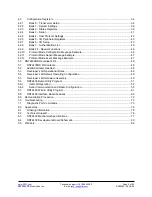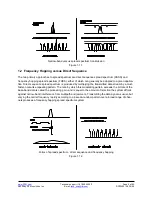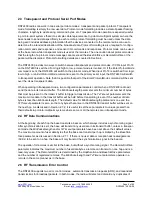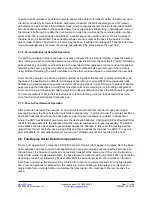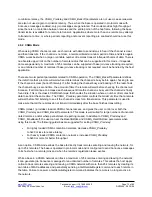
www.RFM.com
Technical s1.678.684.2000
Page 9 of 82
©2009 by RF Monolithics, Inc.
E-mail:
DNT2400 - 08/18/09
2.3 Transparent and Protocol Serial Port Modes
DNT2400 radios can work in two serial port data modes: transparent and packet protocol. Transparent
mode formatting is simply the raw user data. Protocol mode formatting includes a start-of-packet framing
character, length byte, addressing, command bytes, etc. Transparent mode operation is especially useful
in point-to-point systems that act as simple cable replacements. In point-to-multipoint systems where the
base needs to send data specifically to each remote, protocol formatting must be used unless the data
being sent includes addressing information that the devices connected to the remote radios can use to
determine the intended destination of the broadcast data. Protocol formatting is also required for configu-
ration commands and responses, and sensor I/O commands and responses. Protocol mode can be used
at the base radio while transparent mode is used at the remotes. The one caution about protocol mode is
that the length of a protocol mode message cannot exceed the BaseSlotSize or RemoteSlotSize or the
packet will be discarded. Protocol formatting details are covered in Section 4.
The DNT2400 provides two ways to switch between transparent and protocol modes. If /CFG input Pin 18
on the DNT2400 is switched from logic high to low, protocol mode is invoked. Or if the EnterProtocolMode
command is sent, the DNT2400 will switch to the protocol mode. When input Pin 18 is switched from logic
low to high, or an ExitProtocolMode command is sent to the primary serial input, the DNT2400 will switch
to transparent operation. Note that it is possible that part of the EnterProtocolMode command will be sent
over the air as transparent data.
When operating in transparent mode, two configuration parameters control when a DNT2400 radio will
send the data in its transmit buffer. The MinPacketLength parameter sets the minimum number of bytes
that must be present in the transmit buffer to trigger a transmission. The TxTimeout parameter sets the
maximum time data in the transmit buffer will be held before transmitting it, even if the number of data
bytes is less than MinPacketLength. The default value for MinPacketLength parameter is one and the
TxTimeout parameter is zero, so that any bytes that arrive in the DNT2400 transmit buffer will be sent on
the next hop. As discussed in Section 2.7.2, it is useful to set these parameters to values greater than
their defaults in point-to-multipoint systems where some or all the remotes are in transparent mode.
2.4 RF Data Communications
At the beginning of each hop the base transmits a beacon, which always includes a synchronizing signal.
After synchronization is sent, the base will transmit any user data in its transmit buffer, unless in transpar-
ent mode the MinPacketLength and/or TxTimeout parameters have been set above their default values.
The maximum amount of user data bytes that the base can transmit per hop is limited by the BaseSlot-
Size parameter, as discussed in Section 2.7.1. If there is no user data or reception acknowledgements
(ACKs) to be sent on a hop, the base will only transmit the synchronization signal in the beacon.
The operation for remotes is similar to the base, but without a synchronizing signal. The RemoteSlotSize
parameter indicates the maximum number of user data bytes a remote can transmit on one hop and is a
read-only value. The RemoteSlotSize is determined by the HopDuration and BaseSlotSize parameters
and the number of registered remotes. The MinPacketLength and TxTimeout parameters operate in a
remote in the same manner as in the base.
2.5 RF Transmission Error Control
The DNT2400 supports two error control modes: automatic transmission repeats (ARQ), and redundant
transmissions for broadcast packets. In both modes, the radio will detect and discard any duplicates of




